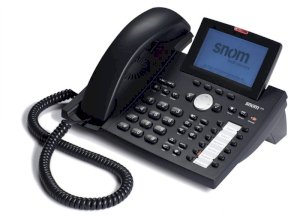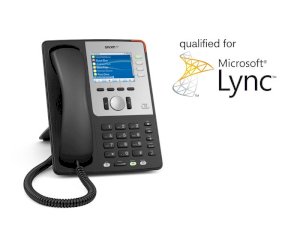Mô tả sản phẩm: Snom 320
The snom 320 has a very low energy consumption (1.0 to 1.5 w-hrs in standby) and the PoE (Power over Ethernet) further helps to decrease costs, while still maintaining high standards.
Snom 320 IP Phone Key Features
Tiltable semi- graphical two-line display
47 keys, 13 LEDs
12 programmable function keys
Speakerphone
2 x IEEE 802.3 10/100 Mbps switch
Power over Ethernet
Headset connection
Display
2 x 24 semi-graphic LCD display
Menu-driven user interface support an uncomplicated feature management
12 programmable keys with LEDs support
Flexible identity access/key configuration
100 number call memory
100 entry onboard address book (to which data may easily be uploaded),
Custom call blocking
Configurable/downloadable ringtones
Auto-answer mode, DND and other sophisticated features
Note: The Snom 320 IP Phone is interoperable with Windows OCS. Please see the following links:
How to Configure Snom OCS
Main Features of Snom OCS
Advantages of Snom OCS [Video]
Snom 320 VoIP Phone Technical Specifications
General Features
Dimensions: approx. 25 x 20 x 12 cm
Weight: approx. 920 g
Certifications: FCC Class B, CE Mark
Power consumption: 2.1 – 2.4 watts
Connectors
1 x LAN, 1 x PC: RJ45 (Ethernet)
Power: 5 V DC
Ethernet: 2 x IEEE 802.3 10/100 Mbps switch
Power over Ethernet: IEEE 802.3af, Class 1
Handset: RJ-4P4C connector
Headset: RJ-4P4C connector
Expansion Module: Proprietary Snom connector
User Interface
2 x 24 character, tiltable semi-graphical display with backlit
47 keys, 12 programmable function keys with LEDs (54 with the expansion module)
Caller-ID
Message waiting indication LED
Address book (100 entries)
Speed dialing
Local dial plan
Number guessing
Lists of missed, received and dialed calls (100 entries each)
Call waiting indication
Clock, daylight saving, call-timer
Call blocking (deny list)
Blocking of anonymous calls
Handling of up to 12 calls simultaneously
Menu-driven user interface
Ring tone selection, import of individual ringtones
URL Dialing support
National language support for selected languages (NLS)
Do not disturb
Speakerphone (full duplex)
Auto answer mode
Keyboard lock
Call Features
Hold
Blind transfer, attended transfer
Music on hold support (only via PBX)
Divert
Conferencing (3-way conference bridge on phone)
Call park, call pickup (only via PBX)
Call completion
Client Matter Code (CMC)
Call waiting/switching between calls
Redialing
RTP multicast paging
Multiple audio device support
Web Server
Embedded web server HTTP/HTTPS
Easy configuration of the phone, remote configuration
Dial from web interface
Password protection
Diagnostics (tracing, logging, syslog)
Security, Quality of Service
HTTPS (server/client)
Transport Layer Security (TLS)
SRTP (RFC3711), SIPS
RTCP, S-RTCP
VLAN (IEEE 802.1X)
LLDP-MED
Codecs, Audio
G.711 A-law, µ-law
G.722, G.729A, G.723.1, G.726
GSM 6.10 (full rate)
Comfort noise, voice activity detection
SIP
RFC3261 compliance
UDP, TCP and TLS
Digest/basic authentication
PRACK (RFC3262)
Error-information support
Reliability of provisional responses (RFC3262)
Early media support
DNS SRV (RFC3263), redundant server support
Offer/answer (RFC3264)
Message Waiting Indication (RFC3842), subscription for MWI events (RFC3265)
Dialog-state monitoring (RFC 4235)
In-band DTMF/out-of-band DTMF/SIP INFO DTMF
STUN client, ICE (NAT traversal)
ENUM (RFC3261), NAPTR (RFC2915), rport (RFC3581), REFER (RFC3515)
Bridged line appearance (BLA)
Auto provisioning with PnP
Busy lamp field support (BLF)






















